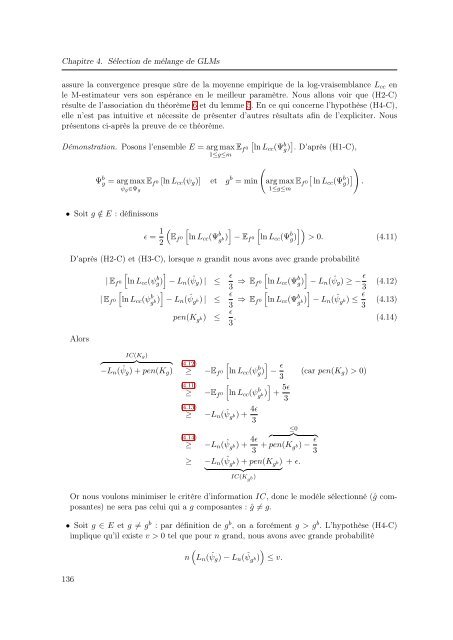Mélanges de GLMs et nombre de composantes : application ... - Scor
Mélanges de GLMs et nombre de composantes : application ... - Scor
Mélanges de GLMs et nombre de composantes : application ... - Scor
Create successful ePaper yourself
Turn your PDF publications into a flip-book with our unique Google optimized e-Paper software.
Chapitre 4. Sélection <strong>de</strong> mélange <strong>de</strong> <strong>GLMs</strong><br />
assure la convergence presque sûre <strong>de</strong> la moyenne empirique <strong>de</strong> la log-vraisemblance L cc en<br />
le M-estimateur vers son espérance en le meilleur paramètre. Nous allons voir que (H2-C)<br />
résulte <strong>de</strong> l’association du théorème 6 <strong>et</strong> du lemme 5. En ce qui concerne l’hypothèse (H4-C),<br />
elle n’est pas intuitive <strong>et</strong> nécessite <strong>de</strong> présenter d’autres résultats afin <strong>de</strong> l’expliciter. Nous<br />
présentons ci-après la preuve <strong>de</strong> ce théorème.<br />
[<br />
Démonstration. Posons l’ensemble E = arg max E f 0 ln Lcc (Ψ b g) ] . D’après (H1-C),<br />
1≤g≤m<br />
Ψ b g = arg max<br />
ψ g∈Ψ g<br />
E f 0 [ln L cc (ψ g )] <strong>et</strong> g b = min<br />
(<br />
arg max E f 0[<br />
ln Lcc (Ψ b g) ]) .<br />
1≤g≤m<br />
• Soit g /∈ E : définissons<br />
ɛ = 1 2<br />
( [ ] [ ])<br />
E f 0 ln L cc (Ψ b g<br />
) − E b f 0 ln L cc (Ψ b g) > 0. (4.11)<br />
D’après (H2-C) <strong>et</strong> (H3-C), lorsque n grandit nous avons avec gran<strong>de</strong> probabilité<br />
[ ]<br />
| E f 0 ln L cc (ψg)<br />
b − L n ( ˆψ g ) | ≤ ɛ [ ]<br />
3 ⇒ E f 0 ln L cc (Ψ b g) − L n ( ˆψ g ) ≥ − ɛ<br />
[ ]<br />
3<br />
| E f 0 ln L cc (ψ b g<br />
) − L b n ( ˆψ g b) | ≤ ɛ [ ]<br />
3 ⇒ E f 0 ln L cc (Ψ b g<br />
) − L b n ( ˆψ g b) ≤ ɛ 3<br />
(4.12)<br />
(4.13)<br />
pen(K g b) ≤ ɛ 3 . (4.14)<br />
Alors<br />
IC(K g)<br />
{ }} {<br />
−L n ( ˆψ g ) + pen(K g )<br />
(4.12) [ ]<br />
≥ −E f 0 ln L cc (ψg)<br />
b − ɛ (car pen(K g ) > 0)<br />
3<br />
(4.11) [ ]<br />
≥ −E f 0 ln L cc (ψ b g<br />
) + 5ɛ<br />
b 3<br />
(4.13)<br />
≥ −L n ( ˆψ g b) + 4ɛ<br />
3<br />
≤0<br />
(4.14)<br />
≥ −L n ( ˆψ g b) + 4ɛ { }} {<br />
3 + pen(K g b) − ɛ 3<br />
≥ −L n ( ˆψ g b) + pen(K g b) + ɛ.<br />
} {{ }<br />
IC(K g b)<br />
Or nous voulons minimiser le critère d’information IC, donc le modèle sélectionné (ĝ <strong>composantes</strong>)<br />
ne sera pas celui qui a g <strong>composantes</strong> : ĝ ≠ g.<br />
• Soit g ∈ E <strong>et</strong> g ≠ g b : par définition <strong>de</strong> g b , on a forcément g > g b . L’hypothèse (H4-C)<br />
implique qu’il existe v > 0 tel que pour n grand, nous avons avec gran<strong>de</strong> probabilité<br />
136<br />
(<br />
n L n ( ˆψ g ) − L n ( ˆψ<br />
)<br />
g b) ≤ v.
















